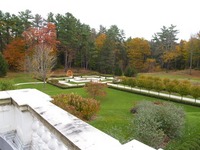Edith Wharton’s estate in Lenox, Massachusetts includes her turn-of-the-century summer house, known at The Mount
view from rear patio, and three-acres of formal gardens all originally envisioned by the author. Known most for writing House of Mirth, Ethan Frome, and Age of Innocence (among other novels), Wharton was also at the forefront of interior and landscape design discourse. She published The Decoration of Houses with friend and architect Ogden Codman, Jr. in 1897 prior to creating The Mount with Codman’s help.
Having grown up in upscale Manhattan with summers in Newport, Wharton created her country estate as a retreat from the confines of her Gilded Age social circle. She chose to create a less overwrought haven than the summer cottages or her peers. At The Mount she put to practice the principles of her design treatise. Preferring the more restrained elegance of Classicism to the Victorian tastes of her time, Wharton designed gardens emphasizing axial views, symmetry, balance, and other European influences.
She believed in treating the landscape as an extension of the home and thus created an ordered exterior procession from The Mount toward the gardens. It starts at the home’s elevated rear brick patio with a tempting overview of the grounds and then moves through outdoor rooms composed of grass terraces bordered by low hedges and transversed by stairs that descend toward a perpendicular crushed limestone path and allee of linden trees. Off in one direction of the allee is a walled Italian garden planted with hostas and ferns; at the other end is a dolphin fountain surrounded by border flower gardens teeming with perennials and annuals.
In contrast to the open vista and rather formal parterre that are evident from the rear of the house, the driveway approach to the property (as conceived by
view from carriage house Wharton’s niece, Beatrix Jones/Farrand) winds dreamily through dense sugar maples creating a sense of privacy and anticipation about what delight may lay ahead. Today, after first visiting the elegant yet worn carriage house composed of tongue and groove wood walls and ceilings, brick floors, and enormous sliding wood-paneled doors, visitors experience the driveway largely on foot, which I imagine only heightens the experience. From within the carriage house you’ll notice the first of many framed views on the property. Here the pristinely framed view is hearty and rugged.
Later, outside the walled southwestern garden you can glimpse a view from one of the rustic stone archways back toward the finely wrought residence. Of course, from within the allee there are exquisite framed views too
view of house from the walled garden. The attention to order, procession, and view in the landscape is as rigorous as it is in the architecture of The Mount. Each is at times both restrained and captivating in presentation.
Thanks to the work of Edith Wharton Restoration, Inc. -- the non-profit owner who enabled the garden’s rehabilitation after years of neglect -- the property can be enjoyed largely as it was originally designed. Of course there have been some substitutions and surmises about what exactly was where more than one hundred years ago, in any case, the result recalls the splendor of an era not to be forgotten.
by Katie Hutchison for the House Enthusiast
To visit go to www.edithwharton.org